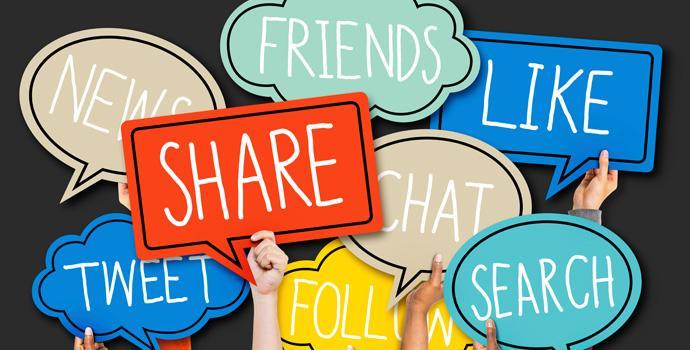
10 Tips for Social Media Connection
Years on from it’s early days, there continues to be hype over the benefits of social media.
In our experience, the way through the hype is a human-centred approach, which puts the ‘interpersonal’ at the heart of your communications.
1. Community
A Facebook ‘like’ is for life, not just for Christmas!
Think about social media connections as community partners rather than simple ‘transactions’. The difference seems subtle but changes the whole way you think about communicating. Partners help each other, give to each other, think about other’s needs, refer business to each other and are supportive. Empathising with your social media community membership is the first step in successful and sustainable digital communication.
2. Start conversations
Ever been to a networking event where people are just touting for clients? Boring - you just want to get out of there. Don’t be that networker.
Talk to people the way you’d like to be talked to yourself: How are you? What are you doing? What are your thoughts on …? These are conversations starters not stoppers. Seek people’s thoughts and opinions as you would if you were at an interesting dinner party. It’s an approach that’s guaranteed to make deeper and more meaningful connections in your social media.
3. Be positive, have fun
Just because it’s in the digital realm, it doesn’t mean your social media conversation has to be impersonal. Give a little of yourself, share what’s comfortable and don’t be afraid to take a stand occasionally. Let your personality shine out, if just a little.
4. Brand
A brand is the sum of your connections with clients and stakeholders: in digital interactions, in meetings, advertising, events, projects, etc. Brand values are on show at every time you connect. Is your brand flashy, consistent, approachable, fun, leading, listening, well-regarded, etc? Consider how your core values are reflected every time you post, tweet, blog or instagram.
5. Before, during, after
Business-related events (conferences, meet-ups, talks) are good chances to ‘embody’ your brand. Attending or talking at an industry event shows you to be a thought leader in your field and participating in a charity event shows you to be a responsible citizen.
So tweet about the event beforehand, connect with others who are going, post what you’re expecting, why you’re going. Once you’re at the event tweet about it, post photos, connect with people there online, answer and pose questions.
Finally, follow up; say what happened. Sometimes thoughts only occur to you later, so post them as they come up. Don’t be afraid to reflect on the event and what it meant to you or your clients, how you can apply the learnings, and engage the new friends you’ve met.
Remember, there’s plenty of topical, relevant content in every event of gathering so don’t pass it up for one second!
6. When things go wrong
What will you do if someone responds negatively to your posts? Do you respond aggressively and in the moment, respond factually, do you delete the comment? The key here is to be consistent; consistent with your brand and personal values.
We recommend taking a few moments to consider the worst case scenario – such as a campaign that encourages people to upload photos and discovering inappropriate photos. A consistent approach would be to be polite but firm, restate the purpose of the campaign and remove the photos with an explanation.
7. Make your posts shareable
What turns people on in your industry? Pictures of children, industry news, new research, innovative products, or cat videos? Think about the formats that people tend to share – infographics, videos, pictures or text. Bring out your inner sleuth and observe what tends to get shared by your followers and connections, then mimic some of this yourself. It’s not a trick, it’s another way of helping your followers get the information they want in a form that they want.
8. Crowdsource
Social media is a good way of getting ideas about your business and its direction. User generated content (UGC) is also a good way to save time and get your connections to contribute what they like. Don’t be afraid to put your problems out there and get the crowd to solve them: “Anyone know a good Drupal web developer?” People love being asked for their advice and sometimes it’s good to be in their debt so you can repay them later with your advice.
9. Choose channels
We’ve left this to towards the end but it’s often the most asked question we get. Should we be on Facebook or Twitter, etc.? The answer is really around who the audience you want to communicate with is and where they hang out. The bottom line for choosing the right channel is that the technology is always changing so what is a good platform today may not be in 2 years. You can’t avoid the work of thinking about your audience, doing your research on where they hang out and tailoring your messages to the different needs of those audiences whether it be on Facebook, Twitter, Google+, Instagram, Pinterest, etc. etc. etc. (get my point?).
10. Practice
… makes perfect. It’s OK to fail if you’re trying something new. Be conscious that some of the time your posts and tweets will be met with stony silence. That’s OK because it can help you refine your message. Sometimes you’ll hit the jackpot and get lots of great engagement and interest for your content.
If you keep your interpersonal approach, start the conversations you and your audience are interested in, bring your personality to bear, be true to your brand, take up opportunities to create interesting, useful, shareable content then your social media will create the communities you want to have around you and your organisation.





Add new comment